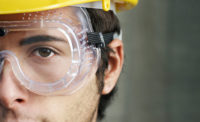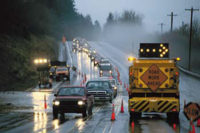More than 1,000 workers suffer fatal accidents on construction sites across the United States every year. When it comes to non-fatal accidents, the number of recordable injuries climbs to nearly 70,000. Improving health and safety in the industry is a priority.
Industry bodies and individual businesses have been committing resources to make job sites more secure for crews. Despite their efforts, accidents keep happening. The digital transformation of the industry is now opening up new opportunities to improve working conditions and worker safety. Building information modeling (BIM) is one of the key tools available to increase safety within the industry.
Reducing the risks of accidents
Before looking more closely at how building information modeling can improve health and safety within the construction industry and the built environment, it is worth clarifying the concept. BIM generates digital representations of the functional and physical characteristics of buildings and construction sites.
For thousands of years, architects have used models to share their vision. Today, digital technology is making these models far more powerful. Rather than offering one fixed representation, digital models can be altered and follow the actual project’s progress. Leading construction companies have been using them to increase efficiencies and improve profit margins. However, only a few companies are taking advantage of their potential to reduce the risk of accidents.
BIM can increase safety at every stage of a construction project, from pre-construction to post-completion. Contractors may start by identifying key risks and hazards to create a specific health and safety file for the project. If that information already exists, the new assessment may add details to it.
Digitally-based BIM systems make it easy to share updated information with all relevant parties, including architects and designers. If necessary, the model can just as easily be updated to reflect any design changes. Once complete, the BIM can then be used by the contractor to update practical, on-site health and safety measures.
After the project has been completed, the details contained within a BIM can be kept in their existing form or updated further with building certificates and a building manual.
Reducing uncertainty and improving mental well-being
Complex construction projects can put contractors under enormous amounts of stress. The Center for Workplace Mental Health counts construction among the industries where growing mental health concerns exist. Reasons include the deadline-driven nature of the work and long work hours. In addition, the center refers to the potential for a large amount of overtime work causing fatigue.
Used to improve health and safety on-site, BIM can identify potential risk areas. With risk areas made obvious, project managers and site managers are able to prepare suitable strategies to help prevent accidents from happening.
By using BIM to identify where accidents and incidents are most likely to occur, contractors can reduce the uncertainty of not knowing how best to protect their workforce. As a result, BIM can help reduce the stress levels of everyone involved in a complex project. On-site and off-site, mental well-being improves, and the risk of accidents is lowered.
Effective investigation of accidents
It would be unrealistic to think that digital technology will entirely prevent accidents on construction sites. Aside from having the power to decrease the number of incidents, it also makes it easier for contractors and the entire industry to investigate and learn from accidents.
Assuming contractors have used BIM consistently from the beginning of the project, they can access detailed information relating to any specific area of the project. Reviewing previous iterations of risk assessments will simplify identifying where safety provisions can be strengthened and procedures changed in time for the next project.
Accidents can only be investigated effectively when all parties involved in a project understand that the goal is learning from a problem rather than appropriating blame. When team members fear being blamed for a problem, they are less likely to voice concerns about an existing building information model. As a result, learning opportunities could be lost. Creating a culture of openness with a strong focus on learning can prevent this loss.
Improve preparations for individual tasks
An effective building information model allows crews to review the details of individual tasks before they need to be completed. Digital modeling offers highly detailed information, including various perspectives.
Project managers and site leaders can update their modeling software with completed tasks and note any potential health and safety issues that needed to be addressed. That information is then used to update the model’s predictions for upcoming tasks.
Construction crews benefit from having the most up-to-date safety considerations and recommendations available to them when they begin work on a new task. Accident risks caused by outdated information can virtually be eliminated.
Visual representation of site conditions for workers
Models allow everyone on a construction project to share the architect’s vision and understand what the finished project should look like. For many workers, foremen, and managers, this will create a deeper understanding of the project requirements than verbal instructions only. Consequently, every team member is in a better position to pinpoint risks and contribute toward mitigating them.
Understanding site conditions in-depth helps teams to better prepare for critical and high-risk parts of a given project. As new information becomes available, it can be used to update the BIM to further improve the quality of the model.
Final thoughts
As part of the industry’s digital transformation, technologies including BIM have allowed construction companies of all sizes to work more efficiently. By streamlining different aspects of their projects, companies have been able to deliver projects more cost-effectively. Applying these principles and technologies to health and safety is the logical next step.
Right now, construction is considered a high-risk industry. Implementing digital solutions including modeling can help improve the industry’s record on safety and limit the risks workers are exposed to on-site. Improving worker safety contributes to on-time and on-budget delivery of projects, improving contractors’ bottom line in the process.




